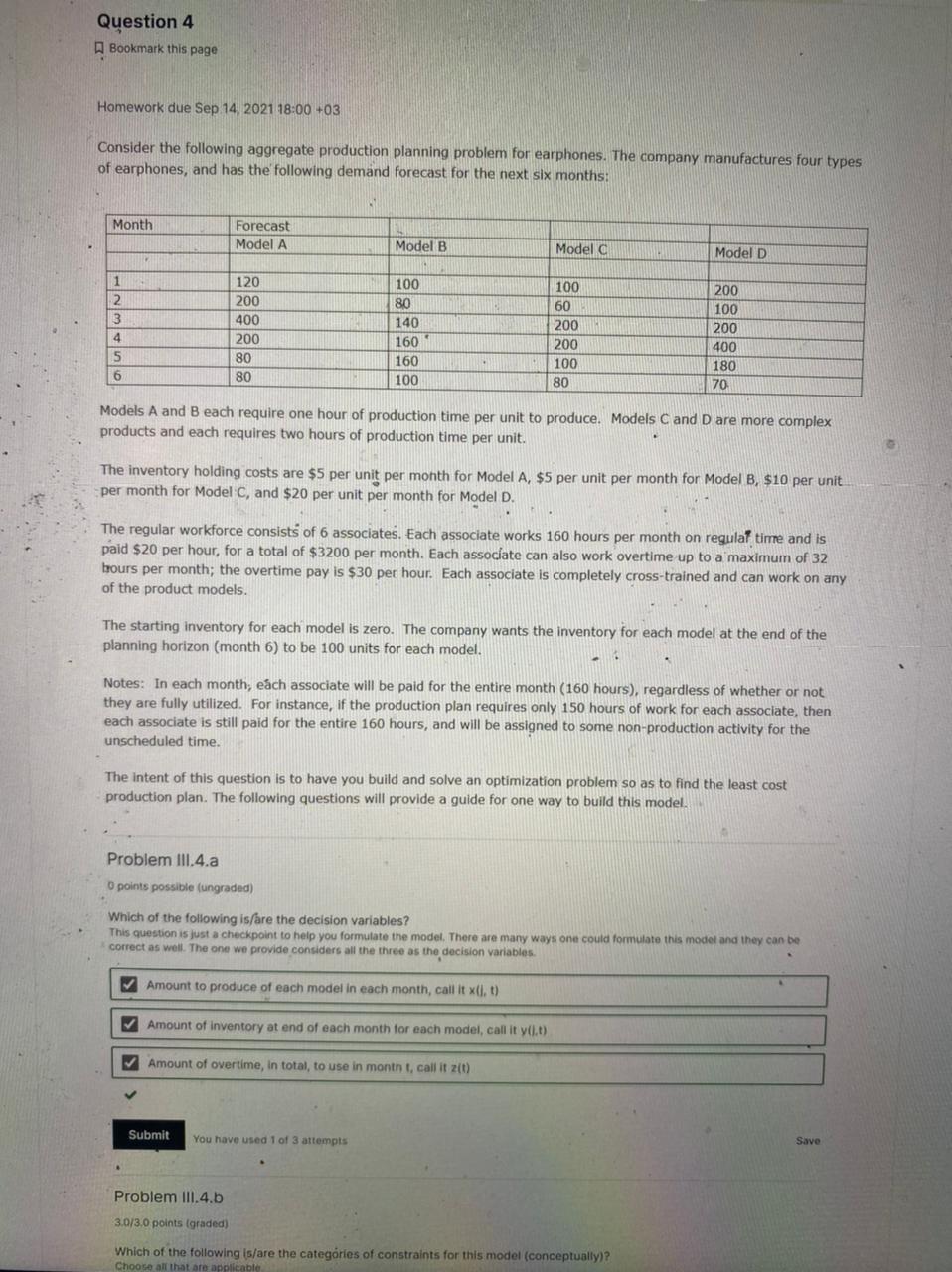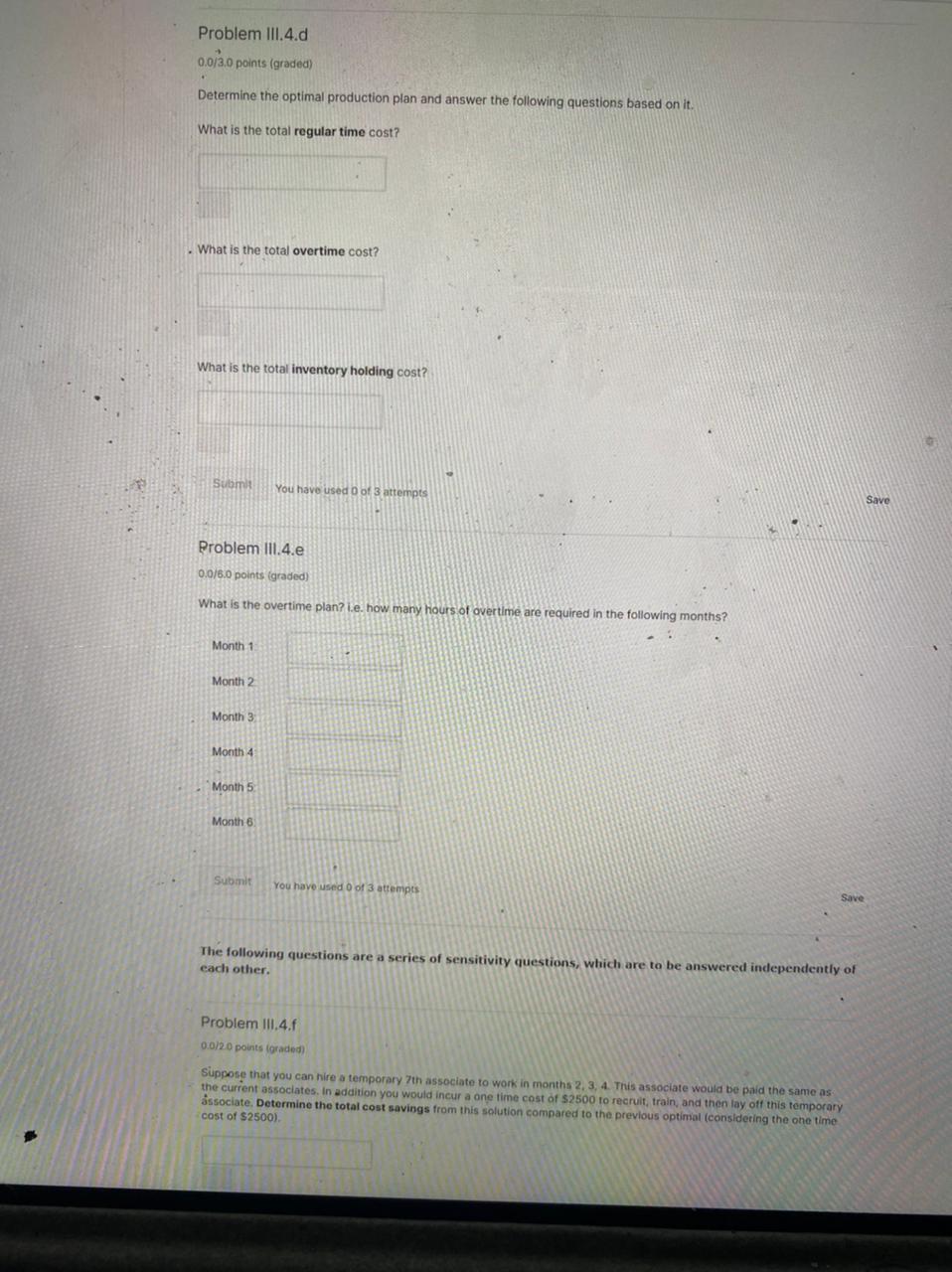Answered step by step
Verified Expert Solution
Question
1 Approved Answer
Question 4 A Bookmark this page Homework due Sep 14, 2021 18:00 +03 Consider the following aggregate production planning problem for earphones. The company



Question 4 A Bookmark this page Homework due Sep 14, 2021 18:00 +03 Consider the following aggregate production planning problem for earphones. The company manufactures four types of earphones, and has the following demand forecast for the next six months: Month Forecast Model A Model B Model C Model D 1 120 100 100 200 .2 200 80 60 100 3 400 140 200 200 4. 200 160 200 400 80 80 160 100 180 100 80 70 Models A and B each require one hour of production time per unit to produce. Models C and D are more complex products and each requires two hours of production time per unit. The inventory holding costs are $5 per unit per month for Model A, $5 per unit per month for Model B, $10 per unit per month for Model C, and $20 per unit per month for Model D. The regular workforce consists of 6 associates. Each associate works 160 hours per month on regular time and is paid $20 per hour, for a total of $3200 per month. Each associate can also work overtime up to a maximum of 32 brours per month; the overtime pay is $30 per hour. Each associate is completely cross-trained and can work on any of the product models. The starting inventory for each model is zero. The company wants the inventory for each model at the end of the planning horizon (month 6) to be 100 units for each model. Notes: In each month; ech associate will be paid for the entire month (160 hours), regardless of whether or not they are fully utilized. For instance, if the production plan requires only 150 hours of work for each associate, then each associate is still paid for the entire 160 hours, and will be assigned to some non-production activity for the unscheduled time. The intent of this question is to have you build and solve an optimization problem so as to find the least cost production plan. The following questions will provide a guide for one way to build this model. Problem IlII.4.a O points possible (ungraded) Which of the following is/re the decision variables? This question is just a checkpoint to help you formulate the model. There are many ways one could formulate this model and they can be correct as well. The one we provide considers all the three as the decision variables V Amount to produce of each model in each month, call it x(), t) V Amount of inventory at end of each month for each model, call it y().t) V Amount of overtime, in total, to use in month t, call it z(t) Submit You have used 1 of 3 attempts Save Problem III.4.b 3.0/3.0 points (graded) Which of the following is/are the categries of constraints for this model (conceptually)? Choose all that are applicable Problem III.4.d 0.0/3.0 points (graded) Determine the optimal production plan and answer the following questions based on it. What is the total regular time cost? What is the total overtime cost? What is the total inventory holding cost? Submit You have used o of 3 attempts Save Problem III.4.e 0.0/6.0 points (graded) What is the overtime plan? Le. how many hours of overtime are reguired in the following months? Month 1 Month 2 Month 3 Month 4 Month 5 Month 6 Submit You have used o of 3 attempts Save The following questions are a series of sensitivity questions, which are to be answered independently of each other. Problem III,4.f 0.0/20 points (igraded) Suppose that you can hire a temporary 7th associate to work in months 2, 3, 4. This associate would be paid the same as- the current associates. In addition you would incur a one time cost of $2500 to recruit, train, and then lay off this temporary associate. Determine the total cost savings from this solution compared to the previous optimal (considering the one time cost of $2500). The following questions are a series of sensitivity questions, which are to be answered independently of each other. Problem III.4.f 0.0/2.0 points (graded) Suppose that you can hire a temporary 7th associate to work in months 2, 3, 4. This associate would be paid the same as the current associates. In addition you would incur a one time cost of $2500 to recruit, train; and then lay off this temporary associate. Determine the total cost savings from this solution compared to the previous optimal (considering the one time cost of $2500). Submit You have used 0 of 3 attempts Save Problem III.4.g 0.0/2.0 points (graded) Suppose you are worried about excessive reliance on overtime. What is the cost impact from reducing the maximum number of overtime hours from 32 to 24 hours per month? Determine the new total cost. Submit You have used O of 3 attempts Save Problem III.4.h 0.0/2.0 points (graded) Suppose the marketing department is considering a campaign that would boost the demand forecast for Model D from 400 t 500 units in month 4. The gross margin for Model D is $75, so this campaign could increase the revenue by $7500. By how much will the production costs increase? Include the cost of holding inventory. Does the increase in revenue cover the increase in cost? O Yes ONo Save Submit You have used O of 3 attempts Earphones (External resource) Aggregate Production Planning: Earphones You can use this MATLAH biock to calculate your answers
Step by Step Solution
There are 3 Steps involved in it
Step: 1

Get Instant Access to Expert-Tailored Solutions
See step-by-step solutions with expert insights and AI powered tools for academic success
Step: 2

Step: 3

Ace Your Homework with AI
Get the answers you need in no time with our AI-driven, step-by-step assistance
Get Started


